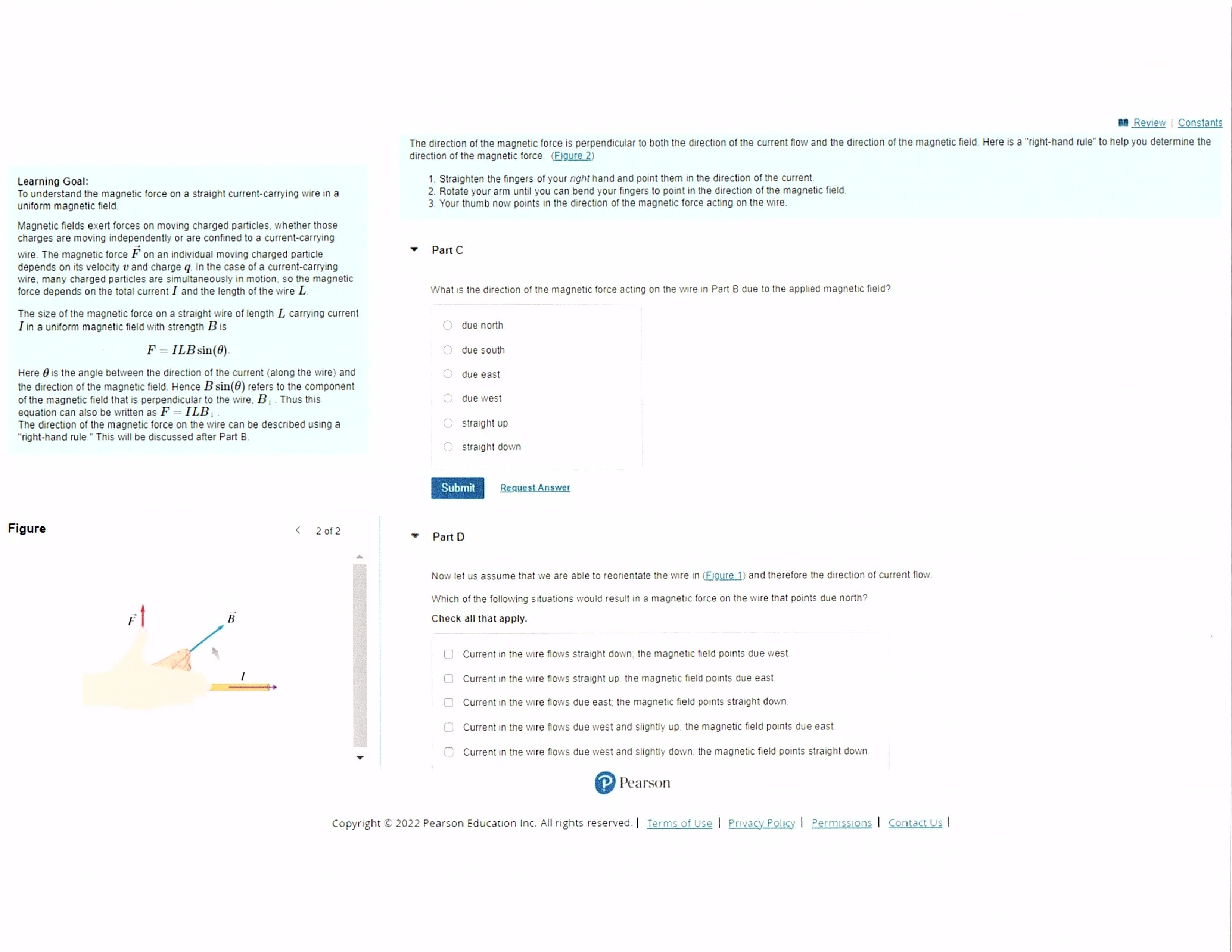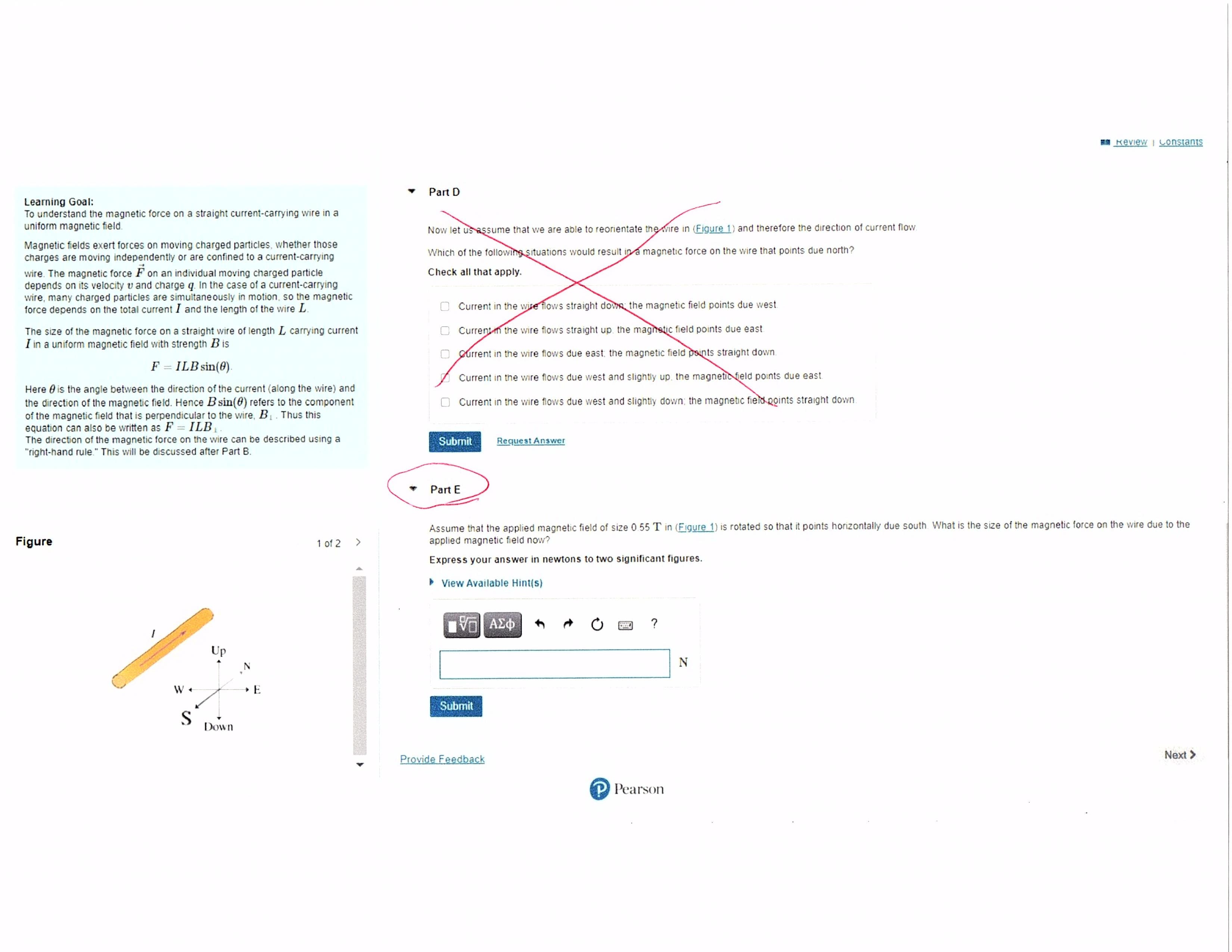Learning Goal: To understand the magnetic force on a straight current-carrying wire in a uniform magnetic field. Magnetic fields exert forces on moving charged particles, whether those charges are moving independently or are confined to a current-carrying wire. The magnetic force F on an individual moving charged particle depends on its velocity v and charge q. In the case of a current-carrying wire, many charged particles are simultaneously in motion, so the magnetic force depends on the total current I and the length of the wire L. The size of the magnetic force on a straight wire of length L carrying current I in a uniform magnetic field with strength Bis F = ILB sin(0). Here 0 is the angle between the direction of the current (along the wire) and the direction of the magnetic field. Hence B sin(0) refers to the component of the magnetic field that is perpendicular to the wire, B. Thus this equation can also be written as F = ILB The direction of the magnetic force on the wire can be described using a "right-hand rule." This will be discussed after Part B.
Learning Goal: To understand the magnetic force on a straight current-carrying wire in a uniform magnetic field. Magnetic fields exert forces on moving charged particles, whether those charges are moving independently or are confined to a current-carrying wire. The magnetic force F on an individual moving charged particle depends on its velocity v and charge q. In the case of a current-carrying wire, many charged particles are simultaneously in motion, so the magnetic force depends on the total current I and the length of the wire L. The size of the magnetic force on a straight wire of length L carrying current I in a uniform magnetic field with strength Bis F = ILB sin(0). Here 0 is the angle between the direction of the current (along the wire) and the direction of the magnetic field. Hence B sin(0) refers to the component of the magnetic field that is perpendicular to the wire, B. Thus this equation can also be written as F = ILB The direction of the magnetic force on the wire can be described using a "right-hand rule." This will be discussed after Part B.
Physics for Scientists and Engineers, Technology Update (No access codes included)
9th Edition
ISBN:9781305116399
Author:Raymond A. Serway, John W. Jewett
Publisher:Raymond A. Serway, John W. Jewett
Chapter29: Magnetic Fields
Section: Chapter Questions
Problem 29.12OQ
Related questions
Question
Please help with PART C, D and E

Transcribed Image Text:BR Review I Constants
The direction of the magnetic force is perpendicular to both the direction of the current flow and the direction of the magnetic field. Here is a "right-hand rule" to help you determine the
direction of the magnetic force. (Eigure 2)
Learning Goal:
To understand the magnetic force on a straight current-carrying wvire in a
uniform magnetic field.
1. Straighten the fingers of your nght hand and point them in the direction of the current.
2. Rotate your arm until you can bend your fingers to point in the direction of the magnetic field.
3. Your thumb now points in the direction of the magnetic force acting on the wire.
Magnetic fields exert forces on moving charged particles, whether those
charges are moving independently or are confined to a current-carrying
wire. The magnetic force F on an individual moving charged particle
depends on its velocity v and charge q. In the case of a current-carrying
wire, many charged particles are simultaneously in motion, so the magnetic
force depends on the total current I and the length of the wire L.
Part C
What is the direction of the magnetic force acting on the wire in Part B due to the applied magnetic field?
The size of the magnetic force on a straight wire of length L carrying current
I in a uniform magnetic field with strength B is
due north
F = ILB sin(0).
due south
Here 0 is the angle between the direction of the current (along the wire) and
the direction of the magnetic field. Hence B sin(0) refers to the component
of the magnetic field that is perpendicular to the wire, B . Thus this
equation can also be written as F = ILB.
The direction of the magnetic force on the wire can be described using a
"right-hand rule. " This will be discussed after Part B.
due east
due west
straight up
straight down
Submit
Request Answer
Figure
2 of 2
Part D
Now let us assume that we are able to reorientate the wire in (Figure 1) and therefore the direction of current flow.
Which of the following situations would result in a magnetic force on the wire that points due north?
B
Check all that apply.
Current in the wire flows straight down; the magnetic field points due west
Current in the wire flows straight up. the magnetic field points due east.
Current in the wire flows due east; the magnetic field points straight down.
Current in the wire flows due west and slightly up. the magnetic field points due east
Current in the wire flows due west and slightly down; the magnetic field points straight down.
Pearson
Copyright © 2022 Pearson Education Inc. All rights reserved. Terms of Use I Privacy Policy I Permissions I Contact Us I

Transcribed Image Text:O O
A Keview I ConstantS
Part D
Learning Goal:
To understand the magnetic force on a straight current-carrying wire in a
uniform magnetic field.
Now let us assume that we are able to reorientate the vire in (Figure 1) and therefore the direction of current flow.
Magnetic fields exert forces on moving charged particles, whether those
charges are moving independently or are confined to a current-carrying
wire. The magnetic force F on an individual moving charged particle
depends on its velocity v and charge q. In the case of a current-carrying
wire, many charged particles are simultane ously in motion, so the magnetic
force depends on the total current I and the length of the wire L.
Which of the following situations would result in a magnetic force on the wire that points due north?
Check all that apply.
Current in the wire flows straight dowe the magnetic field points due west.
The size of the magnetic force on a straight wire of length L carrying current
I in a uniform magnetic field with strength B is
Current in the wire flows straight up. the magnetic field points due east.
Qurrent in the wire flows due east the magnetic field points straight down.
F = ILB sin(0).
Current in the wire flows due west and slightly up. the magneticNield points due east.
Here 0 is the angle between the direction of the current (along the wire) and
the direction of the magnetic field. Hence B sin(6) refers to the component
of the magnetic field that is perpendicular to the wire, Bị. Thus this
equation can also be written as F = ILB.
The direction of the magnetic force on the wire can be described using a
"right-hand rule." This will be discussed after Part B.
Current in the wire flows due west and slightly down; the magnetic fieldQoints straight down.
Submit
Request Answer
Part E
Assume that the applied magnetic field of size 0.55 T in (Figure 1) is rotated so that it points horizontaily due south What is the size of the magnetic force on the wire due to the
applied magnetic field now?
Figure
1 of 2
>
Express your answer in newtons to two significant figures.
• View Available Hint(s)
ΑΣφ
?
Up
N
W +
Submit
S
Down
Provide Feedback
Next >
P Pearson
Expert Solution
This question has been solved!
Explore an expertly crafted, step-by-step solution for a thorough understanding of key concepts.
This is a popular solution!
Trending now
This is a popular solution!
Step by step
Solved in 2 steps

Knowledge Booster
Learn more about
Need a deep-dive on the concept behind this application? Look no further. Learn more about this topic, physics and related others by exploring similar questions and additional content below.Recommended textbooks for you

Physics for Scientists and Engineers, Technology …
Physics
ISBN:
9781305116399
Author:
Raymond A. Serway, John W. Jewett
Publisher:
Cengage Learning

College Physics
Physics
ISBN:
9781938168000
Author:
Paul Peter Urone, Roger Hinrichs
Publisher:
OpenStax College


Physics for Scientists and Engineers, Technology …
Physics
ISBN:
9781305116399
Author:
Raymond A. Serway, John W. Jewett
Publisher:
Cengage Learning

College Physics
Physics
ISBN:
9781938168000
Author:
Paul Peter Urone, Roger Hinrichs
Publisher:
OpenStax College


College Physics
Physics
ISBN:
9781305952300
Author:
Raymond A. Serway, Chris Vuille
Publisher:
Cengage Learning

College Physics
Physics
ISBN:
9781285737027
Author:
Raymond A. Serway, Chris Vuille
Publisher:
Cengage Learning

Physics for Scientists and Engineers
Physics
ISBN:
9781337553278
Author:
Raymond A. Serway, John W. Jewett
Publisher:
Cengage Learning